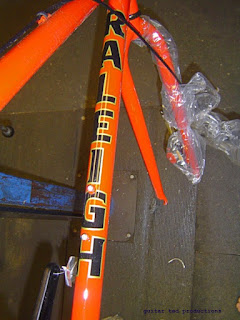In this post I wanted to cover reactions to this story. While it is true that other, smaller brands have done consumer direct sales, this is about one of the so-called "Big Four" brands in the USA. Anchor retailers for the specialty chain bicycle market which have a huge influence upon what you experience as a consumer here in bicycle shops. Those brands are Trek, Specialized, Giant, and Cannondale.
So, right up front I want to dispel the notion that this isn't a 'big deal' because other companies have been doing this. That is not the point here. It is the impact of the influence on the retail landscape in bicycle sales that matters here.
The Stage: First of all, we are in challenging times from the perspective of how retail bicycle shops have been affected by a two-year long upheaval in inventory levels due to the pandemic. Shelves are only partially filled and certain bicycle models and types have been 'out of stock' for months with back-orders still to be fulfilled going back to 2021. Meanwhile, the industry in the Far East- where most of the Big Four brand's bikes are made - is taking off time right now for Chinese New Year and when they come back, they will be working on 2023 models. Shipping and warehousing issues have product sitting on ships and on docks worldwide and when- IF - the bottlenecks get cleared up, (some are saying by the end of this year), supply chain issues should clear up. Meanwhile, bike shops are left waiting on a glut of inventory which will have to be paid for eventually.
The big question: "Will the sales be there when the inventory finally hits the floor?"
Now while all this is happening, consumer trends have changed. There is more on-line shopping than ever. At the same time, bike shops are failing or shrinking in numbers. Trek has gobbled up a lot of retail as a result, making them the #1 specialty bicycle retailer in the USA. Specialized, and I would assume Giant and Cannondale as well, have been pushed out as each new Trek acquisition becomes a one-brand store, whereas they used to be shops which sold multiple brands.
In the meantime Canyon, and other smaller brands, have moved to D2C sales further eroding the market for independent bicycle retail outlets in sales and numbers. Enter in "Rider Direct".
The Effect: Immediate reaction to the news from the industry was mostly negative. Most fear that this is a big blow to independent bicycle retail. This reaction comes from the continued observance by owners of retail shops of shrinking 'margins' for complete bicycle sales. Perhaps a quick mention of how bicycle retail works is in order here.....
 |
| Time spent unwrapping and assembling a bicycle is part of the cost. |
When a bike shop sells a bike, it hopefully makes its full 'margin' on the sale. This is the amount of money above and beyond the cost of the bicycle to the retailer, but there is more to it than that simple monetary figure. Retailers must also include whatever wages their assemblers make across the time it takes to assemble each bike. For instance, if a shop employee making minimum wage, or slightly higher, assembles a bicycle and it takes an hour, (typical time for average bikes), that wage paid for that hour has to be accounted for in the 'cost to do business' on that particular bike. Add in any time spent handling the box the bike came in, which includes off-loading the bike from the freight company's truck, storing the box before assembly, and disposing of the waste after assembly. Add in your daily cost to keep the lights on, pay the rent, etc. Suddenly it is painfully obvious that only making 40% of the cost of a bicycle as 'profit' is not enough.
A quick example: Bike cost to retailer = $450.00 - Margin target is 40%. Retail bike price = $630.00. Profit after sale = $180.00. (Note: A commenter to this post pointed out that I had confused "margin" with "mark-up". Here's the comment: "You are confusing markup with margin. Margin is calculated by profit on the sale divided by selling price. So if the retail price is $630, 40% margin would be $252. ($630 x .40)" )
That $180.00 is where the wages for assembly, handling, and cost of business has to come from. This is assuming no discounts and does not take into consideration how long a bicycle sits on a sales floor, in a back room, or in a box in a storage room/building/warehouse waiting to be assembled. And I am sure I am missing some costs here. Keep in mind also that expensive bicycles typically do not get sold at a 40 margin. Generally speaking, those bikes make even less money for retailers, AND they typically demand a higher paid technician to assemble them AND more time to set up.
I could go way down a rabbit hole here- But suffice it to say that when "Rider Direct" was announced and that dealers were asked to make less margins due to this program, well- It didn't go over very well.
The Future: While some of Specialized's bigger dealers are saying they will try to deal with this and move on, there are indications that others are cancelling orders and/or are dropping the Specialized line. This further plants Specialized into the D2C camp where Canyon and others are doing business. Meanwhile, Trek has already pushed out some of their competition in brick and mortar retail by their voracious appetite for retail outlets. Where does that leave brands that were once a part of a local bike shop? While Trek dealers can- and sometimes do- offer alternative brands in their shops, Trek demands a high percentage of any retailer's inventory be Trek and Bontrager parts and accessories. (By the way, this figure can be 80% or higher- I know from experience)
My feeling is that brands like Cannondale, Giant, and more 'second tier' brands like Kona, Marin, and the like, will have to follow suit with Specialized and especially if Rider Direct shows early success. This will mean more pressure will be exerted on the specialty bicycle retail sector as margins get squeezed even further due to online sales programs like Rider Direct, which only allows up to 75%, and as low as 50%, of what margins were previously.
Meanwhile, I suspect that the numbers of independent, stocking bicycle retailers will begin to fall in numbers. That is a bad sign for consumers. First off- with more single-brand retailers you won't get unbiased information anymore. Secondly, you will have a harder time finding a bike shop in medium sized cities, (and smaller sized cities already lost their LBS's a long time ago), so even getting to see and test ride bikes will begin to be a thing of the past in many more places.
Some dealers are saying online sales are such a small percentage of actual sales that things like "Rider Direct" don't matter. But it depends on how the brand prioritizes sales and distribution. Trek seems to be behind their dealers. It has been expressed in comments sections online that Cannondale and Specialized are not so dealer-centric and that both brands prioritize fulfilling online sales before dealer sales. If true that could mean bad things for dealers and consumers who like the physical aspects of going to a retail bike shop.
But- I could be 100% off my rocker here. We'll see. I think one thing is certain- things are going to change and change fast.


6 comments:
Your example is incorrect. You are confusing markup with margin.
Margin is calculated by profit on the sale divided by selling price. So if the retail price is $630, 40% margin would be $252. ($630 x .40)
@Unknown - Thanks gfor clearing that up. The point remains that it is not a good deal that Specialized has proposed to its dealers.
It's already pretty hard to find any bike other the a Big 4 in most shops. I live in inland Southern California (in the 14th largest metropolitan area in the country). One local chain stocks exclusively Trek and Specialized, with their accessories being nearly all Bontrager. The other local chain is mostly Cannondale and Giant, with some Scott and Felt thrown in; they say they sell Surly, but I've never seen one on their floor.
Seven years ago I drove all over Southern California look to test ride and an All City or Salsa with no luck. Then only Space Horse I could find to test belonged to the owner of a fairly well known shop.
Choice, except through DTC, is pretty rare already and it's going to get worse. Fortunately I'm of an age where I probably only have one bike left in me and of know what I like that my last bike will probably be custom.
I really feel for the retailers (of any size) that have helped these larger manufacturers get to where they are, only to have the rug pulled out from under them. Some interesting comparisons can be drawn between this, and the fact that car makers can now longer own dealerships.
So many mixed feelings about this. On the one hand I could care less about what the Big Four are doing (let alone the bikes and accessories they're selling), on the other the potential loss of brick and mortar shops in mid-sized cities will be a serious blow.
I wonder if there's an opportunity here for bike shops to move to smaller brands (Kona, Scott, Raleigh, All City, etc.), or if those brands are just niche products and its a totally different market? One would hope for some kind of initiative by smaller manufacturers, assuming they haven't all gone consumer direct already.
I'm an experienced enough mechanic to only visit my local shop if it's an unusual repair requiring very specialized tools, and I haven't bought a complete bike from a shop in over 20 years. But I like knowing my local shop is there if I need them. They do advocacy on behalf of cyclists and are--dare I say it--a source of community, and even those of us ignore the Big Four would hate to see this disappear.
I always hate drawing parallels between industries, but what I've been seeing in bikes the last 15 years is a lot like cars the last 40; every company is using all the data they can get to move toward an "ideal" middle ground.
In the auto side of this, new car consumers have moved away from caring what kind of car they have (other than status, or infotainment, etc). Folks who do care have really exploded the used car & aftermarket markets. The range of customization has never been larger.
I see something similar happening every day with the bike market. Used & classic bikes are getting more expensive & harder to find for sale, but the customization markets for those bikes had really blown up. Example: "26" is dead", but I can still get cheap to premium 135 hubs, narrow to wide rims, even wide-range 1x9 clutch drivetrains. The only original parts left on my only mountain bike (a 2000 hardtail) are the frame & seatpost clamp, & everything's been put on in the last 5 years...
Never a better time to customize, but also never a better time to buy without test riding, since manufacturers are teaching a middle ground in parts, materials, & geometry, yet bikes have never been more versatile/capable.
Just my opinion
Post a Comment